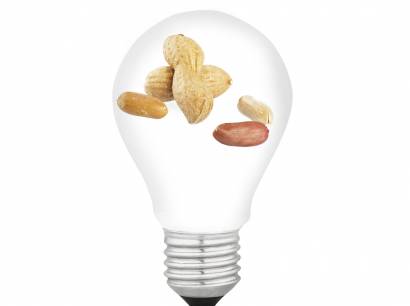This Week's Story
Homely peanuts disguise mind-boggling possibilities discovered by Mr. Carver.

This Week’s Story relives American history and the Bible through brief inspiring stories presented on mp3 audio recordings and text for reading.
Mr. Peanut's Story - Sequel
“Mr. Peanut, are you old?”
“Yes, Goober, I’m at least 500 years old.”
“How come you’re called Mr. Peanut, but I’m called Goober? We’re both peanuts.”
“Well kid, peanuts have many names. Goober is from an African word, nguba, and it’s a nickname for foolish boys. My name comes from peanuts being cousins to peas, and tasting and looking like nuts.”
“How did we get to the United States?”
“It was a long trip! Our first home was in South America. Then men dug up our family and shipped us to Europe. The people there didn’t think we tasted good. They sent us to the New World, but we weren’t liked there either. Most of us left.”
“That’s sad, Mr. Peanut. Where I live, people like us. They eat peanuts for snacks and peanut butter and jam sandwiches for lunch."
“That’s good. They ought to have healthy brains and hearts.”
“Mr. Peanut, how did we get back to the New World?”
“We were good survivors. Some of us went to Asia and Africa. When Africans were sold in the New World as slaves, they brought us with them.”
“How did we become popular there?”
“We were the answer to an American catastrophe. Boll weevils attacked. Those bugs marched north across the Mexican border and began gobbling buds off cotton plants. The farmers were desperate. They started listening to George Washington Carver. He was a brilliant ex-slave who had become a plant scientist. Already he had been telling farmers, “Peanuts are packed with protein and essential nutrients.” Many farmers weren’t convinced, but when they saw their cotton crops being destroyed, they started growing peanuts.”
“What made people buy the peanuts?”
"That was a puzzle. George separated a peanut into its parts and he asked, ‘God, what do I do with the parts?’
“George said that God told him, ‘I gave you three scientific laws, which are temperature, pressure, and compatibility. Take these peanut parts and put them together using these laws. You will see why I made the peanut.’
“For almost three days and nights George worked in his laboratory. He mixed, heated, cooled, and applied pressure to the peanut parts. He took little naps in his chair, ate no meals, but he did snack on peanuts.
“At the end of three days he invited students and faculty of Tuskegee Institute, where he taught, to see the results. They were astonished to see the great variety of inventions George had made from peanuts. There were containers with peanut milk, peanut butter, bleach, washing powder, shampoo, facial cream, plastic, shaving cream, and ink. There was even fine paper and paving stone made from peanut shells.
“Factory owners were contacted and shown products they could produce and sell. They bought tons of peanuts. George kept inventing more products from peanuts. By the 1920’s he was called ‘Mr. Peanut Man.’
“Goober, I wish you could hear him speak. He was scheduled to speak for ten minutes to the Ways and Means Committee of the United States House of Representatives. Instead for one hour and forty-five minutes he hypnotized the congressmen with his show of products made from peanuts.
“George’s inventions extended far beyond peanuts, but with peanuts he created over 300 products. He told his students, ‘There is no such thing as waste in God’s world. Every part of the peanut has a use; it is up to us to discover it.’
This is Barbara Steiner privileged to see puzzle pieces with you. Please check out thisweeksstory.com.
<< previous story] [next story >>
We invite your comments! [click here to comment]
This Week's Story is a non-profit supported by listeners. [click here to make a donation]
 click here to play audio
click here to play audio